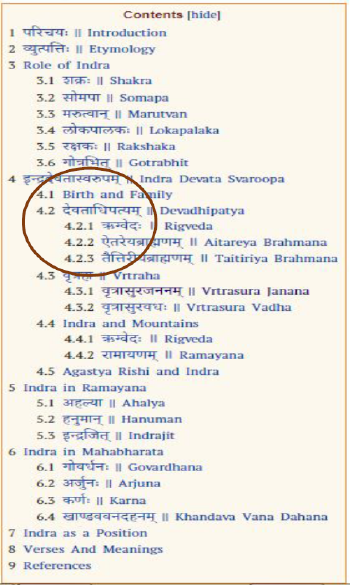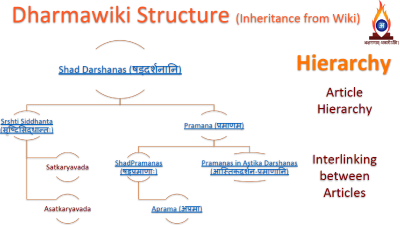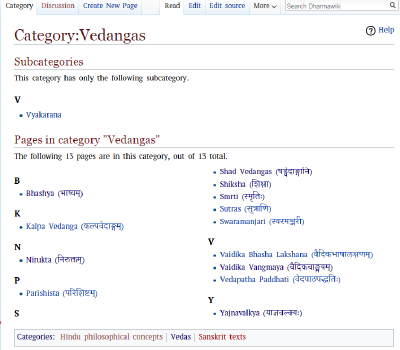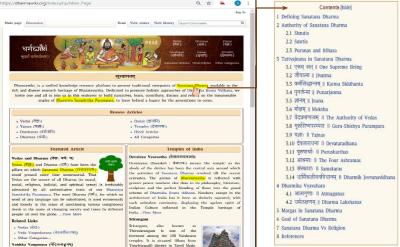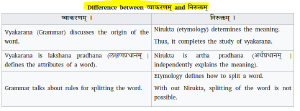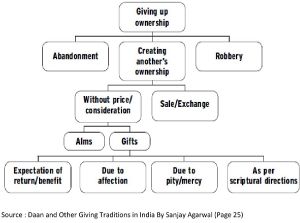Article Structure
Article structure pertains to the various aspects of article presentation in the site. This page introduces a new Author to the different aspects of article structure along the lines of Wikipedia. Articles (including information pages about gurukulas) have a few basic aspects such as the writing style, font, interlinking to further indepth content, classification into categories, a reference section and other details.
Articles have a page layout which is simple, highly organized and powerful in design. Page aspects include
- Table of contents
- Sections (lead section) and Subsections following the lead section or Introduction (as circled in the example)
- Formatting tools (such as bullet points and numbered lists)
- Flags and Pointers (such as To Be Edited, Need Citations) are placed to highlight the future action requirements of the article
- Images
- Tables
- Flowcharts
- Verses and Meanings for additional reading
- Discussion (when appropriate to present additional contemporary perspectives)
- Reference Section
Images, Flowcharts, Tables are value additions in the site to enhance taking across the concept to the reader.
Hierarchy and Categories
Hierarchy of articles is built through the Category structure. This helps the Authors and Readers to easily navigate through the site and add relevant pages under appropriate headings. One main article leads to important topics and from there articles on sub-topics are created.
By adding a "category" in the article we can also place it under different categories. This basically for sorting articles and identify the required article. For example, Agni can be placed under both Vedas and Devatas. Similarly Shad Vedangas are placed both under Vedas and Vedangas.
Linking of Articles
Well inter-linked, or cross-referenced articles are a very important feature to enable easy navigation and enhances userfriendliness.
Text highlighted in blue color as seen in an article indicates that there is a link to another relevant article being built with further in-depth of information. Holding the mouse over the link will often show to where the link will lead. On clicking over it, it will lead the reader to the relevant full article.
Intrasite Links
Intrasite links refer to the crosslinking of articles that are present in the site. They help the reader in getting a comprehensive picture of the subject matter as well as lead the authors to create the relevant content. Clicking on the Panchamahayajnas link leads to a full article about that topic.
Intersite Links
Referencing of articles to external sources such as books and articles available in the internet leads to Intersite site articles. More details are found under the reference section.
Value Additions
On Dharmawiki we strive to make reading delightful by simplifying the concepts while making it easy on the eyes along. Audio clips and videos make it easier for those who prefer listening to reading (for example while driving). Hence we add images and flowcharts to break the monotonous stretch of reading content. Concepts are organized into tables and flowcharts.
It may be noted that copyrighted pictures of images, pictures, temples, vidoes, books and references are all used on the site after obtaining permission from the publisher or the author of the book or review papers or the photographer. Due acknowledgements are given under the pictures when relevant and also on the site in the Acknowledgments section.
Flowcharts are extremely good in presenting the concept across in a lucid manner. Hence we promote using them on this portal.
Flags and Pointers
Another important aspect of page layout includes inclusion of flags and pointers to bring the attention of users to further the development of an article and make it more rigorous.
Similarly to draw attention of the author to provide reference to a particular section or statement in an article the {{citation needed}} flag is added.
Reference Section
At the end of most articles, there is a relevant References section where the references cited in the article are automatically placed as a built-in feature of the software.
Referencing may be done to the following
- external websites and webpages (kamakoti.org, vedicheritage.gov.in etc)
- books which are available online (open source or permitted to use such as Hindu Dharma by Chandrasekharendra Paramacharya)
- reference material such as Ph.D theses (archives, repositories such as Shodhganga)
- dictonaries such as Shabdakalpadruma and Vachaspatyam
